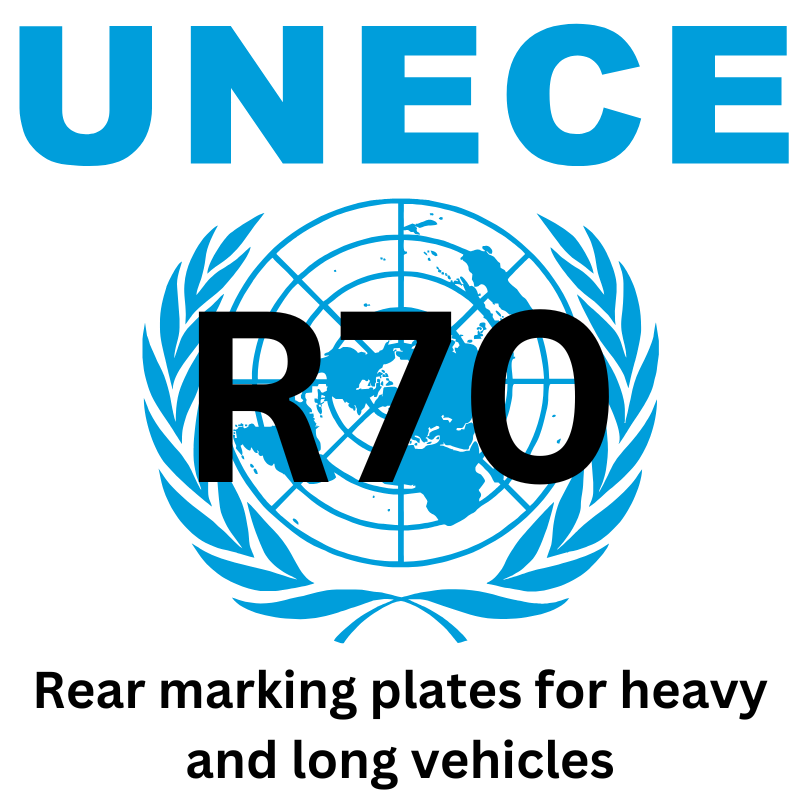Guide To: UNECE R70 - Rear marking plates for heavy and long vehicles
23 July 2023

Guide To: UNECE R70 - Rear marking plates for heavy and long vehicles
UNECE Regulation No. 70 establishes technical provisions concerning the approval and use of rear marking plates for heavy and long vehicles. These plates are crucial for enhancing the visibility of large vehicles on the road, especially during night-time or poor visibility conditions. The regulation specifies the design, performance, and installation requirements to ensure these marking plates effectively serve their safety purpose.
Overview of UNECE Regulation No. 70
The regulation applies to rear marking plates used on various types of heavy and long vehicles, including:
- Heavy vehicles (such as trucks and tractors) categorized as N2 and N3, with the exception of semi-trailer tractors.
- Long vehicles exceeding 8 meters in length, including trailers, semi-trailers, and vehicles categorized under O1 to O4.
Rear marking plates are intended to improve visibility and make it easier for other road users to recognize the vehicle, thus reducing the risk of accidents. These plates are usually rectangular in shape and consist of retro-reflective and fluorescent materials, making them visible from a distance even in low-light conditions.
Key Requirements
The regulation outlines several important specifications:
Material and Colour Specifications:
- The rear marking plates must use retro-reflective and fluorescent materials to ensure high visibility. The retro-reflective portions help in reflecting light, while fluorescent colours improve visibility during daylight and twilight.
- Marking plates for heavy vehicles typically use alternate oblique stripes of yellow and red, while those for long vehicles use a yellow retro-reflective centre with a red border.
Photometric and Colorimetric Standards:
- The regulation prescribes the chromaticity coordinates to ensure the colours are distinguishable and the reflectivity is effective in a variety of lighting conditions.
- These marking plates must meet stringent photometric performance standards to ensure they reflect sufficient light at night or in low-visibility conditions.
Durability and Resistance:
- To guarantee long-term functionality, the rear marking plates must pass tests for heat resistance, corrosion resistance, water resistance, impact resistance, and resistance to fuels and cleaning agents.
- Additionally, the materials must withstand various environmental conditions, including extreme temperatures and high-pressure water jet cleaning without losing effectiveness.
Marking and Installation:
- The regulation also prescribes the size, shape, and installation guidelines for these plates. They must be mounted at a height between 250 mm and 2,100 mm above the ground and should be positioned symmetrically at the rear of the vehicle.
- Markings such as the approval number and a clear identification of the manufacturer must be visible on the plate to confirm it meets UNECE standards.
UNECE Regulation No. 70 was consolidated into UNECE Regulation No. 150, which covers all retro-reflective devices and markings for vehicles. Regulation No. 150 was developed to unify various regulations (including Nos. 3, 27, 69, 70, and 104) into a single comprehensive regulation to streamline compliance for manufacturers and improve clarity for regulatory bodies.
With the incorporation of Regulation No. 70 into Regulation No. 150, the provisions governing rear marking plates for heavy and long vehicles are now part of a broader framework that simplifies and updates vehicle visibility standards. The merger ensures that retro-reflective and fluorescent materials used for safety markings remain consistent with modern road safety requirements, reducing regulatory complexity for manufacturers and enhancing safety on a global scale.
Conclusion
The importance of UNECE Regulation No. 70 lies in its role in ensuring the visibility of heavy and long vehicles, which are often involved in accidents due to reduced visibility. By setting stringent standards for the materials and installation of rear marking plates, the regulation contributes to safer roads. With its integration into Regulation No. 150, the framework for approving and maintaining these crucial safety devices has been simplified, making it easier for manufacturers to comply with international standards while ensuring the continued safety of large vehicles on the road.